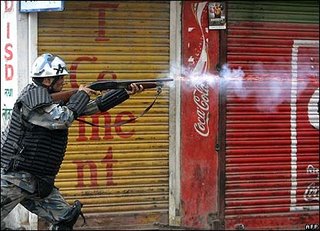In Cahoots With The King

Guardian
British aircraft are used in indiscriminate assaults against civilians in Nepal's war on Maoist insurgents
Isabel Hilton
Tuesday April 11, 2006
Tens of thousands of protesters in Nepal have defied curfews and lethal force on the streets of Kathmandu and other cities to show their rejection of King Gyanendra's rule. At least three people have died, scores have been injured and dozens more arrested.
British aircraft are used in indiscriminate assaults against civilians in Nepal's war on Maoist insurgents
Isabel Hilton
Tuesday April 11, 2006
Tens of thousands of protesters in Nepal have defied curfews and lethal force on the streets of Kathmandu and other cities to show their rejection of King Gyanendra's rule. At least three people have died, scores have been injured and dozens more arrested.
The general strike against the king, due to end yesterday, has been extended by an alliance of Nepal's seven most important political parties, supported by the Maoist insurgents. The protests, which have been growing bigger each day, are reminiscent of pro-democracy demonstrations of the early 90s, which forced the king's predecessor, Birendra, to make concessions. Now people are in the streets to resist Gyanendra's attempts to turn back the political clock.
The king, recently accused of embezzling national emergency funds for his daughter's wedding and to decorate elephants for a coronation that has not taken place, seized absolute power in February 2005. Now his future is looking increasingly doubtful. But beyond the dramatic scenes in Kathmandu there is mounting evidence that his forces are using increasingly indiscriminate tactics in their stalemated war against the Maoists. And in some of the most brutal incidents, equipment supplied by the UK government is directly implicated.
Britain is among several countries that have supplied military and dual-use equipment to Nepal, despite the objections of human-rights organisations that such exports put civilians at risk. Last year, Amnesty International condemned the supply of helicopter gunships and 25,000 rifles from India, 20,000 M16 assault rifles from the US, small arms from the UK, military communications equipment from South Africa and light machine guns from Belgium.
For the UK, the most embarrassing development in the military tactics of the Royal Nepalese Army (RNA) involves two Islander aircraft given to Nepal in 2004, ironically as part of a $4.8m package from the Conflict Prevention Fund. Britain claims not to have supplied lethal aid to Nepal but, as Amnesty International says, there was no end use monitoring to ensure that the aircraft were not later fitted with armaments. Several witness reports have described the use of the Islanders to support the RNA's most lethal tactic - the bombing from helicopters of Nepalese villagers.
In recent incidents, attacks by helicopters with machine guns and mortars have been preceded by the passage overhead of Islander aircraft, apparently for reconnaissance and targeting. One military expert said: "It was predictable that these aircraft would be used as the key part of the killing loop in directing RNA helicopters over locations where mortar bombs would be thrown out and/or machine gun fire sprayed over a large area, and this is exactly what is happening."
The director of the office of the UN High Commissioner for Human Rights in Nepal, Ian Martin, said of these tactics: "One of the things that troubles us most ... is the use of helicopters to fire upon areas where Maoists have allegedly been operating. Even more of concern is the dropping of mortar bombs from those helicopters. Such action cannot properly distinguish, as is required by international humanitarian law, between those who are legitimate targets because they are Maoists fighters, and civilians."

Military experts have watched with alarm the RNA's escalation of aerial attacks. In a recent attack on Thokarpa, north-east of the Kathmandu Valley, where the Maoists were staging a rally in the school, villagers found fragments of a suspected 200mm mortar bomb, developed by the RNA for aerial bombardment. Witnesses reported that an Islander circled as the helicopters rained bombs on civilians and Maoists alike.
The Islander is not a sophisticated spy plane but it is much more economical to fly than a helicopter and can loiter for much longer. Communicating by radio, it works as an aerial observation and command post to direct the helicopter fire. The RNA's aerial attacks on villages are in breach of the Geneva conventions, which enjoin military forces to distinguish between combatants and bystanders. As Martin pointed out, the Maoist's use of civilian locations for their rallies does not relieve the RNA of its duty to protect civilians.
On April 6, the Maoist leader, Prachanda, claimed that his troops shot down one of the helicopters used in the Thokarpa attacks. If his claim is true, how long will it be before one of Britain's "non-lethal" Islanders is shot down in an attack on a Nepalese village?
isabel.hilton@guardian.co.uk
Guardian Unlimited © Guardian Newspapers Limited 2006

0 Comments:
Post a Comment
<< Home